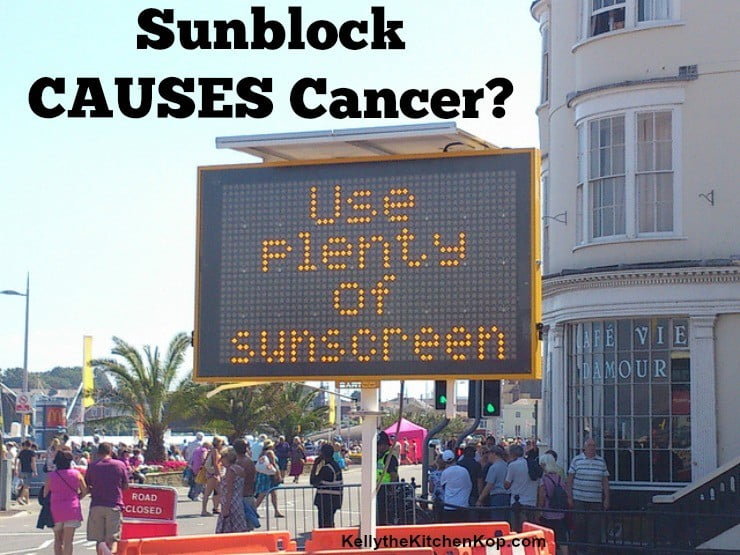
By Joanie Blaxter, founder of Follow Your Gut.
Scary Sunscreen Dangers…
Ahhh, the Summer of Fun 2015 is in full-gear, the crickets and cicadas are singing, waves are crashing, and… all my friends are secretly checking their hidden places for suspicious moles and making appointments to visit their dermatologists, “just to be sure.”
The hammering home for three decades now of the concept that exposure to the sun causes skin cancer has birthed a multi-billion dollar industry of sun products and skin cancer specialists, not to mention two generations of Americans terrified to go outdoors in daylight without “protection.” (Hmm, and we wonder why vampires have become a popular genre…)
With all due respect, the corporations and medical professionals whose profits and incomes will diminish if you stop believing that the sun is our enemy are not going down without a fight. So hang on to your common-sense hat, while we unpack this medical sacred cow step by step.
My 8 “Burning” Issues with Sunscreen Use
1. First of all, if solar exposure is so dangerous, why didn't the human species simply die out thousands of years ago from cancer caused by the sun? Or, at the very least, why don't we only find humans thriving in the “safer,” very northern climates? Why aren't we all, for example, Inuits?
2. Ok, leaping nimbly over that really big elephant in the room, let's assume that prolonged exposure to the sun does, in fact, cause skin cancer.
If that's the case, then those professions who work outdoors – lifeguards, farmers, highway workers, landscapers, etc. – should all have the highest rates of skin cancer.
Not true. In fact, it's the opposite; they have lower rates than office workers and professionals who work indoors in general.
3. Furthermore, if sunlight causes those spots to turn carcinogenic, then you'd expect to consistently find those dangerous moles in areas with the greatest exposure.
Oops. Wrong again. “There's no evidence that melanomas occur at sunburn sites on the body.” In fact, they frequently show up in those areas “where the sun don't shine” like the bottoms of feet, around the genitals, etc.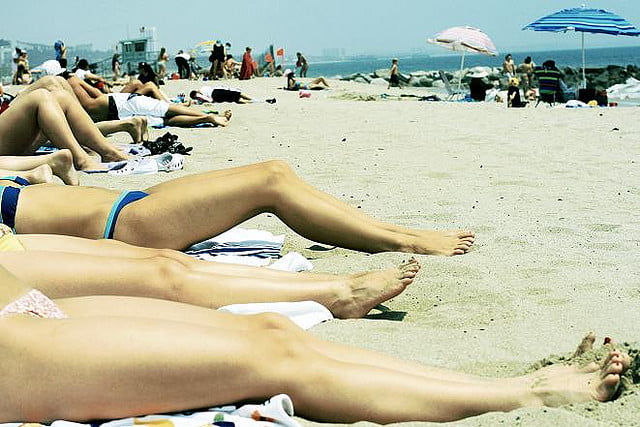
4. And then there's that other elephant lurking in the same room near her sister – that humans are actually designed to make the vitamin D we need, most notably for immune protection (as in anti-cancer benefits), specifically from sun exposure.
Might higher vitamin D blood serum levels due to greater sun exposure explain some of the protection from cancer that outdoor professions experience?
5. Then there's the whole other issue of how the sun-blocking chemicals produced by pharmaceutical manufacturers actually work.
What is the long-term effect on human health of chemically splitting up the sun's spectrum so that whenever we're slathered with sunscreen, we're ONLY EXPOSED TO A PORTION of the sun's light and NOT the full range?
Particularly I wonder how it affects children's growing bodies? Ah. Hasn't been studied.
6. What has, in fact, been studied, however, is those eye-crossingly long chemicals put in products specifically to deflect the sun's rays. And guess what?
The most commonly used, sun-blocking compounds have been shown to cause (wait for it!)… cancer!
(Source: The Trouble with Sunscreen Chemicals. Note: open that link twice to bypass the annoying pop-up that doesn't have a way to click out of.)
7. Sunspray, of course, is the latest thing – so much easier to apply, particularly on those wiggly kids who don't like to sit still for getting coated with lotion.
Except that a new study shows that accidentally inhaling those chemicals – and, let's be realistic, it is the nature of the outdoors to have moving air, so who doesn't inhale the stuff? – turns out to be damaging to the lungs.
(Here's the sunscreen Kelly recommends.)
8. And then there is the issue, virtually never discussed, of the antimicrobials that are put in ALL personal care products. Otherwise, when you open that lid, your sunscreen will have mold in it.
Eeewwww… we don't want that!
And yet, on the other hand, as a result, all commercially made products contain chemicals designed to indiscriminately kill microbes of any kind.
The antimicrobials put in all personal care products, including sunscreen, act as antibiotics when applied to the skin.
While mostly what we hear about are the negative effects on our health of antibiotics consumed orally, the reality is that the antimicrobial substances in commercial personal care products soak directly into our bloodstream and hitch a ride to potentially anywhere in the body, including the gut where they kill the probiotic bacteria you need for (get this)… immune health!
Are you getting the connection?
It's impossible, in my opinion, to have a fully functioning immune system, capable of effectively preventing all forms of cancer, including skin cancer, while we daily absorb through our skin the antimicrobials from our commercially made personal care products.
And drugstore sunscreen packs a double whammy of both potentially cancer-causing chemicals as well as antibiotic antimicrobials.
Where the Misconceptions About the Dangers of Sunlight Comes From
What's critical to understand when unpacking this complex issue is that there are 3 types of skin cancers:
- Basal Cell Carcinoma (BCC) and
- Squamous Cell Carcinoma (SCC), both relatively superficial and therefore, harmless, and
- Melanoma, which is an often aggressive and deadly form of cancer.
Sun exposure does increase the rate of the almost-always harmless Basal Cell Carcinomas and Squamous Cell Carcinomas.
Sun exposure does NOT, however, increase the only form of skin cancer you really want to avoid, melanoma.
In the past, the malignant form, melanoma, was always tracked by the census office separately from the benign BCC and SCC.
Then, about three decades ago, the U.S. changed that policy and reclassified the harmless varieties in with the deadly.
Why? My fallback for political mysteries is always the same mantra: Follow the Money. Were there any industries or professionals involved in that decision that stood to gain financially by the reclassification?
So, the media began reporting how the rate of skin cancer was skyrocketing, rapidly followed, unsurprisingly, by sales for sunscreen and visits to dermatologists. And, decades later, the..
Journal of the American Academy of Dermatology recently reported that 9 out of 10 excisions are, in fact, unnecessary.
Remember when we used to call them “age spots” and nobody thought twice about it? Now everyone over the age of 30 runs off to the dermatologist to get them burned off, honestly believing they just had a near-death experience.
And, no, redheads and blondes do not need to “protect” from sun exposure to prevent melanoma.
Redheads and blondes DO need to be extra vigilant about checking for the early warning signs of melanoma, but that is because they appear to have a genetic predisposition unrelated to the amount of time they spend in the sun.
Avoiding Unnecessary Surgical Procedures
I LOVE SunSpot ES Gel from Lane Labs!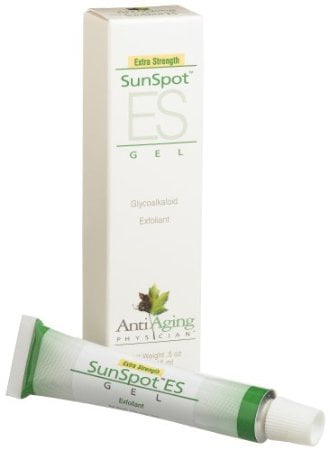
If a mole looks suspicious, I go to my dermatologist for diagnosis. If she says it appears to be the harmless BCC or SCC, with her approval, I decline the expense and pain of surgery and, instead, apply the SunSpot.
SunSpot consists of plant alkaloids which are described as being both slightly irritating as well as more easily absorbed by the abnormal, darker cells on the surface of the normal skin. Hence, after applying it twice a day for 4-5 days, I have been able to literally scrape off several moles and underneath was pink, healthy skin.
Several years ago I asked the chemist owner of an essential oils manufacturer to explain to me how the plant alkaloids in SunSpot exactly work.
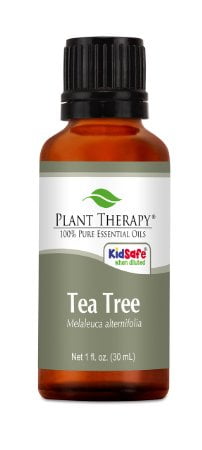 He confirmed that alkaloids are more easily absorbed by the darker cells, but that he used the highly alkaloid tea tree oil instead. He then pulled off the band-aid soaked in tea tree oil on his leg to show me how much the spot underneath had shrunk simply from that essential oil application.
He confirmed that alkaloids are more easily absorbed by the darker cells, but that he used the highly alkaloid tea tree oil instead. He then pulled off the band-aid soaked in tea tree oil on his leg to show me how much the spot underneath had shrunk simply from that essential oil application.
See these other great articles from Kelly about her experience with deciding to remove an ugly, but harmless, BCC: I have Basal Cell Carcinoma (Skin Cancer) and Still Won't Avoid the Sun. Also, Sunshine Benefits – Don't Be Afraid of the Sun! Here's my skin cancer update! 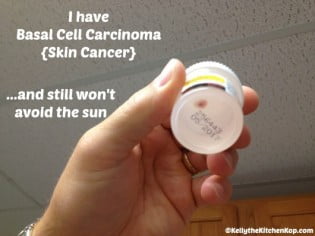
How To Protect Children from Sunburn
All children need to spend time outdoors, playing. So when my daughter was a toddler, I made it a point to let her wear a bathing suit as soon as possible in the spring and early summer, so she could begin to build a suntan base. And it worked! I had to watch her time in the sun carefully, of course, but for the most part she turned a lovely, naturally protective shade of golden brown.
Ironically, now, at age twenty-eight, my daughter complains about how easily her ivory skin burns when she heads out to the beach on weekends. And to look at her, her skin complexion is extremely fair. If I wasn't her mother who knows better, I might believe what she says about being the type that just burns easily no matter what! But if she could be brown as a berry at age two, there's no reason she can't do it now.
I do believe that most everyone, no matter how fair, can build a protective base tan. It just takes persistence and timing.
- Start early in the season (think April and May!) to expose as much of your skin as you can to the sun
- Get some exposure EVERY DAY
- Use clothing and shade as needed
- (Another note from Kelly: Sorry to butt-in, but I concur! I've always done the same thing with our kids. They're outside a lot as soon as it starts getting warm here in Michigan, and they slowly and naturally build up a base. I'm just careful when they're by water though, as the sun is always stronger there and in a bathing suit it'll reach areas beyond normal play clothes, so only then do I put on *more natural sunscreens.)
What's my takeaway over all? 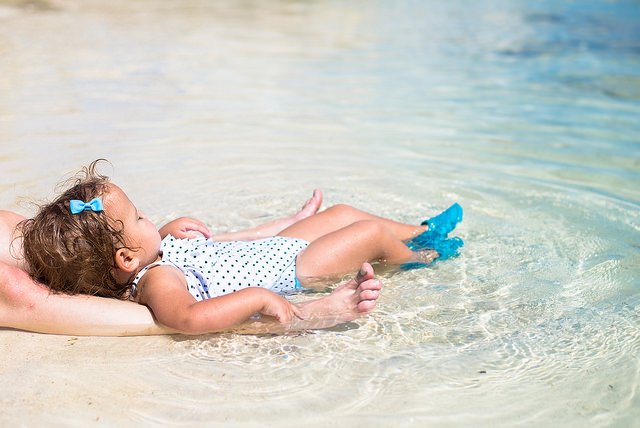
It's far more important to me to protect my immune system and live a long and happy (yes, getting sunlight improves our mental and emotional state) life by spending safe and quality time in the sun than to avoid having a few age spots (be sure to regularly check for the early warning signs of melanoma) and maybe some wrinkles. That means I do this:
- Avoid using drugstore sun lotions with their potentially cancer-causing chemicals.
- Replace the pharmaceutical brands with with homemade lotions and foodgrade oils. (Hint: I use a LOT of coconut oil and ghee and can't wait to try beef tallow!) See below for some homemade sunscreen recipes.
- Make sure I regularly expose my skin to sun to keep my serum vitamin D levels high, while protecting it from burning with shade and clothing so I can build my base tan gradually.
- Get blood serum testing done, at least annually, to make sure my vitamin D levels remain in the anti-cancer range (70 ng/ml minimum). When you ask your doc about this, make sure you are being given the correct test. Go here to read about which one to request.
- Daily eat raw, lacto-fermented foods, supplemented by spore-based probiotics, and follow a GAPS-related diet for optimum gut and immune health.
- Take antioxidants regularly, most importantly, astaxanthin, which I always take with my cod liver oil (to maximize its effects). Personally, I like to take anywhere from 8mg to 12mg daily. Here's what I currently use.
- Keep this commercially made, natural sunscreen on hand for emergencies.
So, the next time you're outside and see a friend whip out their sunscreen, be secretly glad it's not you.
And if you're a teenager, put down your vampire novel, screw up your face and say…
“OMG! Don't spray that stuff near me! You still use chemical sunscreen? That is so, so… 90's!”
(Have you read: Are Spray Sunscreens Safe?)
Recipes and Resources for Homemade Sun Lotions
- How To Make Non-Toxic Homemade Sunscreen: Mommypotamus
- Natural, Homemade Sunscreen: Wellness Mama
- Homemade Sunscreen: Holistic Squid
- Are Zinc & Titanium Safe Alternatives to Chemical Sunscreen? Holistic Squid
- Are Your Skincare Products Toxic? Sunscreen Chris Kresser
 This was a guest post by my sweet friend, Joanie Blaxter, who is now a regular writer around here!
This was a guest post by my sweet friend, Joanie Blaxter, who is now a regular writer around here!
Joanie has been the Ventura County, California chapter leader of the Weston A. Price Foundation since 2010, and you can contact Joanie here for health consultations. Also, find all her past posts here.
Disclaimer: Neither Joanie nor I are health professionals! Use what you read here for your own research and then consult with a natural-minded doctor or health professional you trust to find what is best and right for YOU. Read my entire disclaimer here, and also note that there may be affiliate links in this post.



Joanie Blaxter says
Ask your dermatologist if it’s a BCC or SCC. I don’t bother getting those removed. After all, 9 out of 10 excisions are “unnecessary,” and that’s according to the American Academy of Dermatology. Warning signs can be if the spot gets bigger, turns black, bumpy and/or is itchy. Otherwise, why bother with the unnecessary expense and hassle of surgery?
Rachel Taylor Hedges says
Interesting. I’ve had three spots removed over the past ten years (and I am 43). I’ve been trying to avoid more exposure, but this is having me rethink it.
Fiona Josef says
The sun is not bad for us. Allowing your skin to get burned by the sun, that’s bad for us.
Heather Chilton Wormsley says
Awesome article, Kelly the Kitchen Kop! Born in the 70s, I was always a brown kid/teen. In my late 20s/30s I avoided the sun like the plague…. and ended up with melanoma in-situ. After it’s removal and LOTS of research I am again a sun-bather. People need to know that low D actually increases their risk of cancer.
Joanie Blaxter says
Thank you, Heather! Yes, we were made to be in the sun! Vitamin D is one of the few nutrients that for the most part is not available in food and can’t be made biologically by bacteria in our gut. I too believe that low D levels are very damaging to our immune system.
Doug N Renee Nelson says
I have tried several brands of sunscreen and I break out in a horrible rash. However, after growing up in the 70s when there was no sunscreen, everyone in my family has to deal with having pre cancerous and cancerous spots removed on our skin.
Joanie Blaxter says
Hi Doug, Remember, though, that “the Journal of the American Academy of Dermatology reports that 90% of excisions are, in fact, unnecessary.” To me that’s an admission from the AAD that your family probably doesn’t “have” to get at least 9 out of 10 of those spots removed. If they’re not dangerous, why remove them?
Kelly the Kitchen Kop says
There are also some good suggestions in the linked post.
novusantiquus says
Please don’t make light of squamous cell carcinoma. My grandfather was a farmer, and he developed this form of skin cancer – probably from spending hours in the sun every day completely uncovered (he is very fair and blonde). No, he did not die – but he had to undergo years of painful skin grafting treatments before he was cured. Of course, no one wants melanoma – but no one wants squamous cell carcinoma either.
Joanie Blaxter says
I’m so sorry to hear about your grandfather and his suffering! And very glad to hear that he is recovered. Just to be clear, my emphasis in the article is on the importance of the health of the immune system in combating cancer, no matter the form the cancer takes. Also, I do not suggest in any way that getting sunburned does not matter. I simply have questions about the relatively new (sunscreen has only been in widespread use since about the 60’s) use of a chemical-based sun block.
Joanie Blaxter says
Hi April,
That is an area of a lot of controversy. All I can tell you is I have my own home tanning unit that I use regularly in the winter for both vitamin D production and depression. You may also want to check out what Dr. Mercola has to say: https://articles.mercola.com/sites/articles/archive/2012/04/12/can-tanning-beds-decrease-cancer-than-cause.aspx.
April says
What I’m desperate to know is whether or not tanning beds are an acceptable form of getting vitamin D. I have zero time in my life to lay outside getting sun exposure…